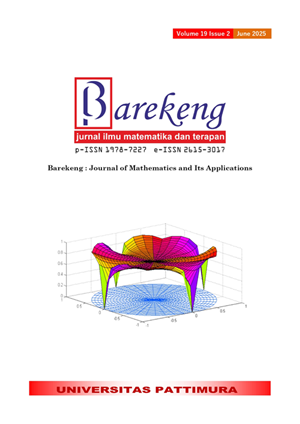ANALYSIS OF THE EXISTENCE OF THE AGRICULTURAL SECTOR IN MODELING POVERTY IN BENGKULU PROVINCE USING GAUSSIAN COPULA MARGINAL REGRESSION
Abstract
Bengkulu Province ranks second in the category of the highest percentage of poor people in the Sumatra region, at 14.62% in March 2022, and sixth in Indonesia, which is undoubtedly one of the fundamental problems that requires mutual attention. The phenomenon of high poverty in Bengkulu Province is inseparable from the lives of people whose main livelihood is in the agricultural sector, especially tenant farmers. Therefore, in this study, the Copula and Gaussian Copula Marginal Regression (GCMR) methods are applied to determine how the agricultural sector affects poverty in Bengkulu Province using secondary data obtained from the Bengkulu Provincial Statistics Agency (Susenas 2022). The results show that the Copula model can identify various types of dependency between the number of poor households in each district/city in Bengkulu Province in 2022 and each of the variables, namely the Number of Agricultural Business Households , the Growth Rate of the Agricultural Sector , the Human Development Index , and the Open Unemployment Rate ( ) by considering the different characteristics of dependency such as top-tail, bottom-tail, or negative dependency. Meanwhile, the GCMR model can provide the direction of influence of the independent variables on the dependent variable Y, where it can be seen that the variables , , and have a negative influence on the variable , whie the variable has a positive impact on the variable . Therefore, in general, it can be concluded that either positive or negative dependencies identified by the Copula model can influence the resulting GCMR model by providing more profound complexity regarding the relationship between the variables analyzed.
Downloads
References
Bappenas, PEDOMAN TEKNIS PENYUSUNAN RENCANA AKSI TUJUAN PEMBANGUNAN BERKELANJUTAN (TPB)/ SUSTAINABLE DEVELOPMENT GOALS (SDGs), Jakarta: Bappenas, 2020.
BPS, BERITA RESMI PROFIL KEMISKINAN DI INDONESIA MARET 2022, Jakarta: BPS, 2022.
P. P. Oktaviana, "PENDEKATAN COPULA UNTUK PENYUSUNAN PETA KERAWANAN PUSO TANAMAN PADI DI JAWA TIMUR DENGAN INDIKATOR EL-NINO SOUTHERN OSCILLATION (ENSO)," 2012.
H. Joe, DEPENDENCE MODELING WITH COPULAS, New York: Chapman and Hall/CRC, 2014.
M. Hofert, I. Kojadinovic, M. Machler and J. Yan, "ELEMENTS OF COPULA MODELING WITH R," pp. 9-79, 2017.
G. Masarotto and C. Varin, "GAUSSIAN COPULA MARGINAL REGRESSION," Electronic Journal of Statistics, vol. 6, pp. 1517-1549, 2012.
Sutikno, H. Kuswanto and D. Ratih, "GAUSSIAN COPULA MARGINAL REGRESSION FOR MODELING EXTREME DATA WITH APPLICATION," Journal of Mathematics and Statistics, vol. 10, no. 2, pp. 192-200, 2014.
C. Czado, R. Kastenmeier, E. C. Brechmann and A. Min, "A MIXED COPULA MODEL FOR INSURANCE CLAIMS AND CLAIM SIZES," Scandinavian Actuarial Journal, vol. 4, pp. 278-305, 2012.
H. O. Pintari and R. Subekti, "PENERAPAN METODE GARCH-VINE COPULA UNTUK ESTIMASI VALUE AT RISK (VAR) PADA PORTOFOLIO," Jurnal Fourier, vol. 7, no. 2, pp. 63-77, 2018.
S. W. Agustini, M. Hadijati and N. Fitriyani, "ANALISIS DEPENDENSI FAKTOR MAKROEKONOMI TERHADAP TINGKAT HARGA EMAS," Eigen Mathematics Journal, pp. 82-91, 2019.
R. B. Nelsen, An Introduction to Copulas, Portland: Springer, 2006.
A. Khairiati, R. Budiarti and I. G. P. Purnaba, "PERBANDINGAN ANALISIS REGRESI LINEAR DENGAN," JAMBURA JOURNAL OF MATHEMATICS, vol. 4, no. 2, pp. 209-219, 2022.
U. Cherubini, E. Luciano and W. Vecchiato, COPULA METHODS IN FINANCE., John Wiley & Sons, 2004.
I. S. Prayoga and A. Ahdika, "PEMODELAN KERUGIAN BENCANA BANJIR AKIBAT CURAH HUJAN EKSTREM MENGGUNAKAN EVT DAN COPULA," Jurnal Aplikasi Statistika & Komputasi Statistik, vol. 13, no. 1, pp. 35-46, 2021.
J. Rizal, A. Y. Gunawan, S. Indratno and I. Meilano, "THE APPLICATION OF COPULA CONTINUOUS EXTENSION TECHNIQUE FOR BIVARIATE DISCRETE DATA: A," Mathematical Modelling of Engineering Problems, vol. 8, no. 5, pp. 793-804, 2021.
A. Khairiati, R. Budiarti and I. G. P. Purnaba, "PERBANDINGAN ANALISIS REGRESI LINEAR DENGAN ANALISIS REGRESI COPULA PADA DATA KEUANGAN," Jambura Journal of Mathematics, vol. 4, no. 2, pp. 209-219, 2022.
BPS, DATA STRATEGIS BPS, Jakarta: BPS, 2012.
Copyright (c) 2025 Sigit Nugroho, Dyah Setyo Rini, Pepi Novianti, Riki Crisdianto, Elisabeth Evelin Karuna, Athaya Fairuzindah

This work is licensed under a Creative Commons Attribution-ShareAlike 4.0 International License.
Authors who publish with this Journal agree to the following terms:
- Author retain copyright and grant the journal right of first publication with the work simultaneously licensed under a creative commons attribution license that allow others to share the work within an acknowledgement of the work’s authorship and initial publication of this journal.
- Authors are able to enter into separate, additional contractual arrangement for the non-exclusive distribution of the journal’s published version of the work (e.g. acknowledgement of its initial publication in this journal).
- Authors are permitted and encouraged to post their work online (e.g. in institutional repositories or on their websites) prior to and during the submission process, as it can lead to productive exchanges, as well as earlier and greater citation of published works.






1.gif)



